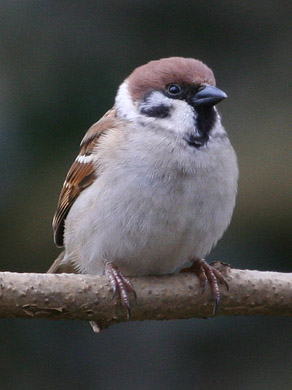
Tree sparrow
The tree sparrow is much rarer than the house sparrow in Europe, and does not live in close proximity to Man as the house sparrow does. In some parts of the world, such as China and Nepal [1], however, the roles are reversed and the tree sparrow takes up the role of the house sparrow in Europe, so they obviously can do it!
It has also suffered a precipitous decline in the UK, about 95% of the birds have been lost in the last 25 years of the twentieth century.
The tree sparrow had a particularly troubled relationship to Chairman Mao Tse-Tung of China, who decreed a purge on them in April 1958.[2] He wanted his population to improve economically during the Great Leap Forward, and observing that the sparrows consumed a fair amount of grain, decided that this would not do.
He decreed that on a certain day the population would go out and bang pots and pans to scare the sparrows, which would eventually die of exhaustion if the population kept this up.
The goal was achieved, and next grain harvest was better than the one before. The next one, however, was a disaster - what Chairman Mao had failed to realise was that the sparrows fed their young on live insects, among them locusts. With a control on the locusts missing, the population exploded and devoured the crops. Between 1959 and 1961 30 million people starved. Not all of this could be ascribed to the persecution of the sparrows, as some of the other things done in the Great Leap Forward were also not wise, but the sparrows had shown their value and the population gradually recovered and people left them be.
Identification - What does it look like?
Unlike the house sparrow, male and female Tree sparrows have similar plumage. The head is an attractive chestnut brown, and there are distinctive black cheek patches. Unlike the house sparrow there is not large black bib, even in the breeding season.
What does it sound like
There is a lot of similarity to the more familiar chirp of the house sparrow. The tree sparrow is pitched a bit higher, and some listeners discern a more distinct 'twang' to the sound.
Breeding
In the UK the breeding season [3]is from late April to late July; in the Northern Hemisphere the start varies with latitude in a similar way to that of the house sparrow. In the UK there are typically three clutches of five eggs over the breeding season, incubated for about 12 days. After hatching the nestlings fledge in approximately two weeks, though they are still dependent on their parents for food.
Issues and conservation status
In the UK we have lost 95% of the population in the last 25 years of the 20th century. The species is on the UK Red List. Unlike the house sparrow, it is easier to comprehend the reasons, changing farming practices being primarily responsible. Conservation efforts are targets on the alleviation of some of these chages, though the low density of tree sparrows makes this hard to do cost-effectively.
Unlike the introduction of the house sparrow to the United States the introduction of the Tree sparrow has not been the cause of major problems. Twenty three Tree sparrows were imported from Germany and relaesed in St Louis on the 25th of April 1870, they are still mainly confined to farmland between the Mississippi and Illinois rivers. there is some suspicion that this is due to competition with the House sparrow, which has a slightly earlier breeding season.
[1] Birds BritannicaBirds Britannica, Mark Cocker, Richard Mabey, 2005
[2] Independent
[3] The Tree Sparrow JD Summers-Smith 1995